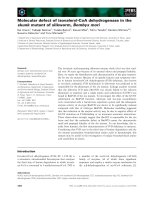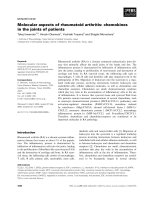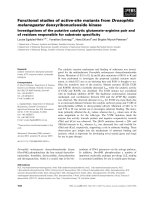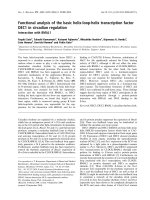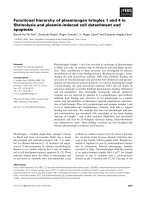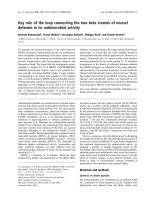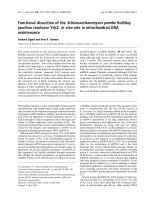Báo cáo khoa học: Functional role of Bb-chain N-terminal fragment in the fibrin polymerization process pdf
Bạn đang xem bản rút gọn của tài liệu. Xem và tải ngay bản đầy đủ của tài liệu tại đây (342.24 KB, 10 trang )
Functional role of Bb-chain N-terminal fragment in the
fibrin polymerization process
E. V. Lugovskoy, P. G. Gritsenko, L. G. Kapustianenko, I. N. Kolesnikova, V. I. Chernishov
and S. V. Komisarenko
Palladin Institute of Biochemistry, National Academy of Sciences of Ukraine, Kyiv
2
, Ukraine
Fibrinogen is a central protein of the blood coagula-
tion system. The human fibrinogen molecule (molecu-
lar mass 344 kDa) consists of two identical subunits
connected by disulfide bonds [1]. Each monomer
subunit is formed by three nonidentical polypeptide
chains, Aa,Bb and c. The N-terminal ends of all six
polypeptide chains are situated in the fibrinogen cen-
tral region, which is known as the E-domain. Two
Keywords
fibrin; monoclonal antibodies; peptides;
polymerization sites
Correspondence
E. Lugovskoy, Palladin Institute of
Biochemistry, National Academy of
Sciences of Ukraine, 9 Leontovicha Street,
01601, Kyiv, Ukraine
Fax: +38 044 2796365
Tel: +38 044 2343354
E-mail:
(Received 15 May 2007, revised 3 July
2007, accepted 10 July 2007)
doi:10.1111/j.1742-4658.2007.05983.x
Four mAbs of the IgG
1
class to the thrombin-treated N-terminal disulfide
knot of fibrin, secreted by various hybridomas, have been selected. Epi-
topes for two mAbs, I-3C and III-10d, were situated in human fibrin frag-
ment Bb15–26, and those for two other mAbs, I-5G and I-3B, were in
fragment Bb26–36. Three of these mAbs, I-5G, I-3B and III-10D, as well
as their Fab-fragments, decreased the maximum rate of fibrin desAA and
desAABB polymerization up to 90–95% at a molar ratio of mAb (or Fab-
fragment) to fibrin of 1 or 2. The fourth mAb, I-3C, did not influence the
fibrin desAABB polymerization and inhibited by 50% the maximum rate
of fibrin desAA polymerization. These results suggest that these mAb
inhibitors block a longitudinal fibrin polymerization site. As the mAbs
retard both fibrin desAABB and fibrin desAA polymerization, one can con-
clude that the polymerization site does not coincide with polymerization
site ‘B’ (B b15–17). To verify this suggestion, the polymerization inhibitory
activity of synthetic peptides BbSARGHRPLDKKREEA(12–26),
BbLDKKREEA(19–26), BbAPSLRPAPPPI(26–36), BbAPSLRPAPPPIS
GGGYRARPA(26–46) and BbGYRARPA(40–46), which imitate the vari-
ous sequences in the N-terminal region of the fibrin Bb-chain, have been
investigated. Peptides Bb12–26 and Bb26–46, but not Bb40–46, Bb19–26,
and Bb26–36, proved to be specific inhibitors of fibrin polymerization. The
IC
50
values for Bb12–26 and Bb26–46 were 2.03 · 10
)4
and 2.19 · 10
)4
m,
respectively. Turbidity and electron microscopy data showed that peptides
Bb12–26 and Bb26–46 inhibited the fibrin protofibril formation stage of
fibrin polymerization. The conclusion was drawn that fibrin fragment
Bb12–46 took part in fibrin protofibril formation simultaneously with site
‘A’ (Aa17–19) prior to removal of fibrinopeptide B. A model of the inter-
molecular connection between fragment Bb12–46 of one fibrin desAA
molecule and the D-domain of another has been constructed.
Abbreviations
1
Bb12–26, BbSARGHRPLDKKREEA(12–26); Bb19–26, BbLDKKREEA(19–26); Bb26–36, BbAPSLRPAPPPI(26–36); Bb26–46,
BbAPSLRPAPPPISGGGYRARPA(26–46); Bb40–46, BbGYRARPA(40–46); NaCl ⁄ P
i
, 0.02 M potassium phosphate buffer (pH 7.4) with 0.13 M
NaCl; t-NDSK, thrombin-treated N-terminal disulfide knot of fibrin; TPBS, NaCl ⁄ P
i
with 0.05% Tween-20.
4540 FEBS Journal 274 (2007) 4540–4549 ª 2007 The Authors Journal compilation ª 2007 FEBS
peripheral regions of the fibrinogen molecule were his-
torically named D-domains. However, it was discov-
ered by X-ray analysis that there were two distinct
bC- and cC-domains in the peripheral D-region [2]. As
a result of the activation of the blood coagulation sys-
tem, thrombin is formed; this attacks fibrinogen and
splits off two fibrinopeptides A (Aa1–16). Fibrinogen
is transformed into fibrin desAA, which is able to
polymerize spontaneously, forming two-stranded pro-
tofibrils with half-staggered fibrin molecules [3,4]. Pro-
tofibrils associate laterally, producing fibrils. The fibrils
also associate laterally, branching and forming a three-
dimensional network, which is the framework of the
whole blood thrombus [5]. It is now widely accepted
that the initial step of fibrin polymerization (protofibril
formation) is carried out by the intermolecular pairing
of ‘A’ and ‘a’ polymerization sites of fibrin monomers.
Site ‘A’ (Aa17–19) is exposed in the N-terminal region
of the Aa-chain by the splitting off of fibrinopeptide A
[6]. Site ‘a’ is formed by amino acid residues cGln329,
cAsp330, cHis340 and cAsp364, situated in the
cC-domain of the fibrinogen ⁄ fibrin molecule [7]. On
protofibril formation, polymerization site ‘B’ (Bb15–
18) is exposed at the N-terminal region of the fibrin
b-chain, when fibrinopeptide B (Bb1–14) is split off by
thrombin and desAABB is formed [6,8]. Complemen-
tary to site ‘B’, a site ‘b’ is formed by amino acid
residues BbGlu397, BbAsp398, BbArg406, BbCys407,
BbHis408 and BbAsp432, localized in the fibrin
bC-domain [7]. The ‘B’–‘b’ pairing leads to structural
rearrangements in the D-domain and the strengthening
of protofibril lateral contacts [9,10].
Many indirect data show that other polymerization
site (or sites) may be situated in fibrin desAA fragment
Bb14–54. For example, fibrinogen-325, lacking frag-
ment Bb1–42, is clotted by thrombin 180 times slower
as compared to intact fibrinogen, and it has been
shown that such a fibrin keeps its monomeric form for
a long time [11,12]. Pandya et al. [13] found an inhibi-
tory effect of peptide Bb15–42 on fibrin polymerization
and showed that this effect was not related to polymer-
ization site ‘B’ (Bb15–18). Moen et al. [14] showed
significantly impaired polymerization of fibrin desAA
obtained from recombinant fibrinogen with histidine
substituted for arginine at Bb14 [14]. We found earlier
that mAb 2d)2a and its Fab-fragment, whose target
epitope involves BbArg14, specifically inhibited fibrin
desAA polymerization [15]. It was also shown that
synthetic peptide Bb40–54 dissociated the (DD)E com-
plex at a 5000 molar ratio of peptide to complex [16].
The Bb28–30 and Bb36–44 regions are framed by pro-
line brackets, which usually indicates that such pep-
tides are involved in protein–protein interactions [17].
Three mAbs to t-NDSK that inhibit fibrin polymeriza-
tion are described in this article. The inhibitory effects
of synthetic peptides Bb12–26 and Bb26–46 on fibrin
polymerization were also studied. The results suggest
that an unknown site (not ‘B’), important for fibrin
polymerization, is situated at fibrin fragment Bb12–46.
This site seems to take part in protofibril formation,
and is operational without fibrinopeptide B being
removed by thrombin.
Results
We have obtained 35 hybridomas producing different
antibodies of IgG
1
class to human fibrin fragment
thrombin-treated N-terminal disulfide knot of fibrin
(t-NDSK) with the molecular structure (Aa17–51,
Bb15–118, c1–78)
2
. Three of these hybridomas secret-
ing mAbs I-5G, I-3B and III-10D were chosen on the
basis of the strong and specific inhibition by these
mAbs of fibrin desAABB polymerization. Turbidity
analysis showed that these mAbs and their Fab-frag-
ments specifically inhibited the maximum rate of fibrin
desAABB polymerization by up to 90–95% at a molar
ratio to fibrin of 1 : 1 or 2 : 1 (Fig. 1). Similar results
were obtained with fibrin desAA (where fibrinopep-
tides B are conserved) and with fibrin produced in the
fibrinogen + thrombin reaction (data not shown).
Such a strong and specific inhibition of fibrin polymer-
ization by mAbs and their Fab-fragments indicated the
specific blockade of a polymerization site situated in
this region of the molecule rather than steric hindrance
by antibodies. Furthermore, this inhibition could not
be explained by the blockade of polymerization site ‘B’
(Bb15–17), as there is no ‘B’ site exposed in fibrin
desAA. The fourth mAb, I-3C, did not influence fibrin
desAABB polymerization but, surprisingly, it inhibited
by 50% the maximum rate of fibrin desAA polymeri-
zation. Figure 2 shows that mAb I-5G reacted in
ELISA with fibrinogen, fibrin desAABB, t-NDSK,
fragment Bb15–118, slightly reacted with c1–78, and
did not react with E
3
-fragment (E
3
-fragment includes
polypeptide constituent b54–120). mAbs I-3B, III-10D
and I-3C reacted with the antigens mentioned above
in the same manner. Immunoblot analysis (Fig. 3)
showed that mAbs I-5G, I-3B, III-10D and I-3C (not
shown) reacted only with the Bb15–118 constituent of
t-NDSK. The slight reaction of mAbs with c1–78 in
ELISA may be explained by the contamination of the
c1–78 preparation with Bb15–118. ELISA and immu-
noblot results indicate that epitopes for all four mAbs
are situated in the Bb15–53 fibrin fragment. K
D
values
of the binding of mAbs I-5G, I-3B, III-10D and
I-3C to t-NDSK were 1.0 · 10
)8
m, 7.4 · 10
)9
m,
E. V. Lugovskoy et al. Functional role of Bb-chain N-terminal fragment
FEBS Journal 274 (2007) 4540–4549 ª 2007 The Authors Journal compilation ª 2007 FEBS 4541
2.3 · 10
)8
m, and 3.7 · 10
)9
m, respectively. The com-
petitive ELISA showed that mAb I-5G competed
with I-3B and mAb III-10D competed with I-3C in
fibrinogen binding. mAbs I-5G and I-3B did not com-
pete with mAbs III-10D and I-3C.
To localize epitopes for these mAbs, the following
peptides comprising human fibrinogen sequences in
Bb12–46 were synthesized: B bSARGHRPLDKKRE
EA(12–26), BbLDKKREEA(19–26), BbAPSLRPAPP
PI(26–36), BbAPSLRPAPPPISGGGYRARPA(26–46),
and BbGYRARPA(40–46). Competitive ELISA was
used to study the binding of mAbs to fibrinogen in the
presence of these peptides. It was found that mAbs
III-10D and I-3C reacted with peptide Bb12–26
(Fig. 4A), and mAbs I-5G and I-3B with peptides
Bb26–36 (Fig. 4B) and Bb26–46 (not shown). There
was no reaction between any of these mAbs with pep-
tides Bb19–26 and Bb40–46. We also found that mAb
I-3C but not other mAbs (III-10D, I-5G and I-3B)
competed with mAb 2d)2a obtained in our laboratory
earlier with an epitope encompassing amino acid resi-
dues BbArg14 and BbGly15 [15]. These results show
that epitopes for mAbs I-3C and III-10D are situated
in fragment Bb15–26, whereas epitopes for mAbs I-5G
and I-3B are situated in Bb26–36 (Fig. 5).
We also found that mAb I-3C but not mAb III-10D
competed with mAb 2d-2a obtained in our laboratory
earlier with an epitope encompassing amino acid resi-
dues BbArg14 and BbGly15 [15]. These data show that
the epitope for mAb I-3C is situated closer to the
N-terminus of fragment Bb15–26 as compared to the
epitope for mAb III-10D. The fact that epitopes
for these two mAbs do not coincide in the frame of
fragment Bb15–26 may explain the difference in their
inhibitory effects in relation to fibrin desAABB poly-
merization.
We suggested that epitopes for these mAbs coin-
cided or overlapped with fibrin polymerization site⁄
sites situated in this region of the molecule. To verify
this suggestion, we investigated the inhibitory action of
Fig. 1. The dependence of the maximum rate of fibrin desAABB polymerization (V
max
) on the molar ratios of mAbs I-5G (A), 1-3B (B), and
III-10D (C), and their Fab-fragments, to fibrin.
Fig. 2. Binding curves of mAb I-5G to the antigens fibrin fragment
Bb15–118, t-NDSK, fibrinogen (F), fibrin desAABB, fibrin fragment
c1–78 and fibrin fragment E
3
adsorbed to microtiter plates (ELISA).
Fig. 3. Immunoblot analysis of reduced t-NDSK using mAbs I-5G,
I-3B, and III-10D. Lane 1: molecular mass markers. Lanes 1–3:
SDS ⁄ PAGE stained with Coomassie R250. Lanes 4 and 5: immuno-
staining with mAb III-10D. Lanes 6 and 7: immunostaining with
mAb I-3B. Lanes 8 and 9: immunostaining with mAb I-5G. Lanes 2,
4, 6, and 8: fibrin fragment Bb15–118. Lanes 3, 5, 7, and 9:
t-NDSK + b-mercaptoethanol.
Functional role of Bb-chain N-terminal fragment E. V. Lugovskoy et al.
4542 FEBS Journal 274 (2007) 4540–4549 ª 2007 The Authors Journal compilation ª 2007 FEBS
synthesized peptides on fibrin polymerization. Turbi-
dity analysis showed that peptides Bb12–26 and Bb26–
46 increased lag-time and decreased the maximum
rate of polymerization of both fibrin desAABB and
fibrin produced in the fibrinogen + thrombin reaction
(Fig. 6A,B). The values of IC
50
(the concentrations of
the peptides at which 50% of inhibition of the fibrin
polymerization maximum rate were observed) for
Bb12–26 and Bb26–46 were 2.0 · 10
)4
m and
2.19 · 10
)4
m, respectively. The final turbidity of fibrin
clots proved to be decreased only slightly (Fig. 6C).
The increase in lag-time may be related to either
increasing protofibril critical length or a decrease in
the rate of protofibril formation. The combination
of three parameters obtained with turbidity analy-
sis ) longer lag-time, lower maximum rate of fibrin
polymerization, and almost the same value of final tur-
bidity ) suggested more the retardation of the first
stage of fibrin polymerization, i.e. protofibril forma-
tion, than inhibition of protofibril lateral association.
The final conclusion on this depended on electron
microscopy findings (see below).
To compare the inhibitory effect of peptides Bb12–
26 and Bb26–46 with the effect of the known inhibitor
of fibrin polymerization, the peptide GPRP, mimicking
site ‘A’ (Aa17–19), we performed some experiments
with GPRP and found the IC
50
value for the latter to
be equal to 2.02 · 10
)5
m. Peptides Bb19–26, Bb26–36
and Bb40–46, at a molar ratio of peptide to fibrin of
1500, did not inhibit polymerization of either fibrin
desAABB or fibrin produced in the fibrinogen +
thrombin reaction. We found also that the mixture of
two peptides Bb26–36 and Bb40–46 at the same molar
Fig. 4. Binding curves of mAbs I-5G, I-3B, III-10D and I-3C to the synthetic peptides Bb12–26 (A) and Bb26–36 (B) in competitive ELISA.
The peptide concentrations varied from 0.39 lgÆmL
)1
to 50 lgÆmL
)1
, and the mAb concentration was constant at 1 lgÆmL
)1
. Fibrinogen was
adsorbed to microtiter plates.
Fig. 5. The amino acid sequence of human fibrin fragment Bb12–
46. The epitope localization for mAbs I-5G, I-3B, III-10D and I-3C is
indicated by arrows.
16
Fig. 6. The influence of the synthetic peptides Bb12–26 and Bb26–46 on fibrin desAABB polymerization in turbidity analysis. The depen-
dence of the lag-time s (A), the maximum rate of fibrin polymerization V
max
(B) and final turbidity Dh (C) of fibrin clots on the molar ratio of
the synthetic peptides to fibrin.
E. V. Lugovskoy et al. Functional role of Bb-chain N-terminal fragment
FEBS Journal 274 (2007) 4540–4549 ª 2007 The Authors Journal compilation ª 2007 FEBS 4543
ratio to fibrin had no inhibitory effect on fibrin poly-
merization.
To determine which stage of fibrin polymerization is
affected by these peptides, we performed transmission
electron microscopy at different stages of the fibrin
polymerization process in the presence of peptides
Bb12–26 and Bb26–46. Electron microscopy showed
(Fig. 7B,C) that fibrin stayed in monomeric form when
peptides Bb12–26 and Bb26–46 were present in poly-
merization media at a molar ratio to fibrin of 1500.
Without these peptides, fibrin formed protofibrils and
their initial lateral associates as usual (Fig. 7A). How-
ever, the cross-striated fibrils were formed in both
cases with and without the peptides studied (Fig. 7D–
F). These data show that peptides Bb12–26 and Bb26–
46 retard the stage of fibrin protofibril formation.
Discussion
The N-terminal fragment of the fibrin b-chain contains
regions related to the polymerization process and to
binding of thrombin and endothelial cells [11,12,18].
The known polymerization site ‘B’ is localized in
sequence Bb15–18 [6]. Considerable indirect data indi-
cate that other polymerization sites may be situated at
the fibrin sequence Bb14–54 [11–16]. mAbs may be
used as molecular probes to study mechanisms of
fibrin polymerization [19–22]. The inhibition of fibrin
polymerization by mAbs at a molar ratio to fibrin of
about 2 or less most probably indicates that the epi-
topes for these mAbs are situated at or near the poly-
merization sites of the fibrin molecule. The specific
retardation of fibrin polymerization by the correspond-
ing smaller Fab-fragments suggests the blocking of a
polymerization site by the mAb or its Fab-fragment
rather than steric hindrance [23].
We have obtained two mAbs, I-3C and III-10d, with
epitopes situated in human fibrin fragment Bb15–26,
and two mAbs, I-5G and I-3B, with epitopes in frag-
ment Bb26–36. Three of these mAbs (III-10d, I-5G,
and I-3B) and their Fab-fragments specifically inhi-
bited fibrin desAABB polymerization (Fig. 1). All of
them, as well as their Fab-fragments, inhibited poly-
merization of fibrin desAA. These results show that
mAbs block a previously undescribed polymerization
site, which is not a short peptide fragment like site ‘A’
(Aa17–19) or ‘B’ (Bb15–17), but comprises a longitudi-
nal amino acid sequence in Bb15–36. As mAbs retard
both fibrin desAABB and fibrin desAA polymeriza-
tion, one can conclude that the blocked polymerization
site does not coincide with polymerization site ‘B’
(Bb15–17).
mAb 2d)2a targets an epitope encompassing the
peptide bond BbArg14-Gly15, which is cleaved by
thrombin [15]. This mAb inhibited the maximum rate
of fibrin desAA polymerization by 60%, whereas its
Fab-fragment inhibited it by 100%, at molar ratios of
antibody to fibrin of 1 and Fab to fibrin of 2, respec-
tively. Moen et al. [14] found impaired polymerization
of fibrin obtained from recombinant fibrinogen with
histidine substituted for arginine at Bb14. Turbidity
analysis showed an increase in lag-time and a decrease
in maximum polymerization rate of this fibrinogen in
the desAA fibrin form. The final turbidity of these
fibrin clots proved to be decreased, and electron
microscopy showed that fibrin fibrils were thinner than
ABC
DEF
Fig. 7. Electron micrographs of negatively contrasted structures formed during fibrin desAABB polymerization in 80 s (A,B,C) and 180 s
(D,E,F) from the start of the process: (A,D) in the absence the synthetic peptides; (B,E) in the presence of Bb12–26 peptide; and (C,F) in the
presence of Bb26–46 peptide. Initial protofibril lateral associates are indicated by arrows. The bars represent 100 nm.
Functional role of Bb-chain N-terminal fragment E. V. Lugovskoy et al.
4544 FEBS Journal 274 (2007) 4540–4549 ª 2007 The Authors Journal compilation ª 2007 FEBS
normal fibrils. It had been concluded that BbArg14
was involved in lateral association of normal fibrin
protofibrils [14]. However, these authors performed
electron microscopy of only the final fibrin clots, and
not fibrin at each stage of the polymerization process.
The question remained unresolved as to when during
fibrin polymerization BbArg14 plays a role. Our results
with mAbs 2d)2a [15] and the data obtained by Moen
et al. [14] with the fibrinogen variant BbArg14His sug-
gest that BbArg14 is involved in another fibrin poly-
merization site localized at the N-terminal fragment of
the fibrin Bb-chain. This site is operational before
fibrinopeptide B is split off.
The inhibitory activity of synthetic peptides mimick-
ing the various fragments of the N-terminal region of
the fibrin Bb-chain was investigated. Two peptides,
Bb12–26 and Bb26–46, but not Bb19–26, Bb26–36, or
Bb40–46, proved to be specific inhibitors of fibrin
polymerization (the IC
50
values for Bb12–26 and
Bb26–46 were 2.03 · 10
)4
m and 2.19 · 10
)4
m, respec-
tively). Turbidity and electron microscopy data showed
that peptides Bb12–26 and Bb26–46 inhibited the stage
of fibrin protofibril formation. We suggest that two
fibrin fragments corresponding to these peptides form
the whole longitudinal site Bb12–46 (we have named it
‘C’), which takes part in fibrin intermolecular binding
during the construction of two-stranded protofibrils
simultaneously with site ‘A’ (Aa17–19). This site ‘C’ is
operational without fibrinopeptide B (Bb1–14) splitting
off; that is, it does not coincide with polymerization
site ‘B’ (Bb15–17). Siebenist et al. found that fibrino-
gen lacking fragment Bb1–42 was clotted by thrombin
but with an essential delay of protofibril formation
[12]. Pandya et al. [13] showed an inhibitory effect of
peptide Bb15–42 on fibrin polymerization, and this
effect was not determined by polymerization site ‘B’
(Bb15–18). Our results obtained with mAb 2d)2a [15]
and with peptide Bb12–26, and the findings of Moen
et al. [14], show that the polymerization site situated at
the N-terminus of the Bb-chain comprises the amino
acid residues localized to the left of the peptide bond
Bb14–15. Pandya et al. [13] did not find an inhibitory
activity for peptide Bb40–54 up to a molar ratio with
fibrin of 1000. However, Moskowitz & Budzynski dis-
covered that this peptide dissociated the (DD)E com-
plex at a molar ratio of 5000 [16]. The latter result and
our data obtained with peptide Bb26–46 show that
polymerization site ‘C’ comprises amino acid residues
to the right of the peptide bond Bb42–43.
Fibrin protofibril formation is carried out by inter-
molecular pairing of ‘A’ and ‘a’ polymerization sites
localized in fibrin central E- and peripheral
D-domains, respectively [3,4]. As polymerization site
‘C’ (Bb12–46) is situated in the E-domain of the fibrin
molecule, the complementary site ‘c’ is suggested to be
situated in the D-domain. We have tried to model the
intermolecular binding between the D-domain of
one fibrin desAA molecule and Bb12–46 of another
(Fig. 8). The model was prepared with the pymol
Molecular Graphics System [24] on the basis of X-ray
analysis data of chicken fibrinogen [25] and of human
D-dimer bound to the synthetic peptide GPRP [7].
X-ray analysis showed that the N-terminal fragments
Bb1–64 and Aa1–27 of the fibrinogen molecule were
not visible on electron density maps, as these frag-
ments were highly disordered and mobile [25,26].
Human fibrinogen fragments Aa21–27 and Bb12–64
were substituted using computer graphics for chicken
fibrinogen fragments Aa1–27 and Bb1–64. In this
model, the C-terminal proline of the GPRP peptide,
which is bound to the D-dimer molecule at site
‘a’, was manually linked to the N-terminal residue
Aa21Val of human fibrinogen fragment Aa21–27. As a
result, we have the possibility of finding the mutual
space orientation between the fibrin desAA molecules
belonging to different strands of protofibril. In the
construction of the model, we have taken into consid-
eration the fact that site ‘B’ (Bb15–18), being the inac-
tive part of the suggested site ‘C’ (Bb12–46), has to be
oriented to the complementary site ‘b’ in the
bC-domain of another fibrin molecule. This model
shows that fragment Bb12–46 of fibrin desAA (site
‘C’) covers a longitudinal complementary site ‘c’ situ-
ated in the bC- and cC-domains of a molecule
γC
γC
βC
BβArg14
D
E
D
βC
‘‘A’’-‘‘a’’
17
Fig. 8. The model (in two projections) of the intermolecular connec-
tion between the D-domain of one fibrin desAA molecule (blue) and
Bb12–46 (magenta) of another. The model was prepared with
PYMOL [24] on the basis of the X-ray analysis data of chicken
fibrinogen [25] and human D-dimer bound with synthetic peptide
GPRP [7].
E. V. Lugovskoy et al. Functional role of Bb-chain N-terminal fragment
FEBS Journal 274 (2007) 4540–4549 ª 2007 The Authors Journal compilation ª 2007 FEBS 4545
belonging to another strand within the protofibril.
After fibrinopeptide B is split off the site, ‘B’ is
formed, and the latter interacts intermolecularly with
the complementary site ‘b’ situated in the bC-domain
in a ‘knob’–‘hole’ type of interaction [7,9]. The remain-
ing part of site ‘C’ (Bb19–46) probably remains bound
to the fibrin D-domain. To determine the localization
of a complementary site ‘c’, it is necessary to perform
X-ray analysis of the complex between D-dimer and
peptide Bb12–46. Recently, Pechik et al. [27] found an
interaction of recombinant peptide (Bb1–66)
2
with
fibrin D-dimer and D-monomer (K
d
¼ 1.3 · 10
)5
m
and K
d
¼ 1.53 · 10
)4
m, respectively), using the sur-
face plasmon resonance method.
Thus, our results suggest that the longitudinal
N-terminal region of the Bb-chain (Bb12–46) or site
‘C’ is involved in protofibril formation simultaneously
with site ‘A’ (Aa17–19) before fibrinopeptide B is
split off. Synthetic peptide GPRP (which mimics the
polymerization site ‘A’) binds to site ‘a’ of fibrinogen
with K
a
1 · 10
4
m [28], whereas fibrin desAA inter-
action is carried out with a K
a
1.56 · 10
7
m [29].
This increase in affinity may be explained by the sug-
gested intermolecular pairing of ‘C’–‘c’ sites. It is
known that fibrinogen is able to polymerize under
special conditions without splitting off fibrinopeptides
A and B, forming cross-striated fibrils [30]. This poly-
meric interaction of fibrinogen molecules may be
explained by the participation of the ‘C’–‘c’ pairing
sites, as both sites are probably exposed in the fibrin-
ogen molecule.
Experimental procedures
Preparation of fibrinogen, fibrin desAA, fibrin
desAABB and t-NDSK
Human fibrinogen was prepared by sodium sulfate precipi-
tation from human plasma [31]. DesAABB fibrin monomer
was prepared as described by Belitser et al. [32]
3
. DesAA
fibrin monomer was prepared by our original method as
described previously [33]. t-NDSK was obtained as des-
cribed by Timpl & Gollwitzer [34]
4
.
Preparation and purification of mAbs
Hybridomas were obtained essentially as described by Ko
¨
h-
ler & Milstein [35]. mAbs were isolated from hybridoma
culture medium by affinity chromatography on fibrinogen
Sepharose 4B, as described elsewhere [36]. The determina-
tion of IgG class and subclass was performed by ELISA
using an Isotyping kit (Clinical Credential; ICN Immunobio-
logicals, Lisle, IL, USA)
5
.
Preparation of Fab-fragments
IgG sample (0.4 mL) (2 mgÆmL
)1
) in 0.02 m potassium phos-
phate buffer (pH 7.4) with 0.13 m NaCl (NaCl ⁄ P
i
) was added
to 1.2 mL of papain Sepharose 4B suspended in digestion
buffer (NaCl ⁄ P
i
with 20 mm cysteine HCl, 10 mm EDTA,
pH 7.0) and incubated for 30 min at room temperature with
stirring. Fab fragments in supernatant were separated from
Fc fragments using 0.4 mL of protein G Sepharose 4B (50%
slurry in NaCl ⁄ P
i
). Desalting and concentration were done
using centrifuge filter units (Ultrafree-15 with Biomax 10K
membrane, Millipore, Bedford, MA, USA)
6
.
Synthesis of peptides
Five peptides comprising human fibrinogen region Bb12–46
(Bb12–26, Bb19–26, Bb26–36, Bb26–46 and Bb40–46) were
synthesized by a solid-phase method (Fmoc chemistry).
ELISA
ELISA was performed in microtiter plates coated with the
following antigens: t-NDSK, fibrinogen, fibrin desAABB,
Bb15–118 and c1–78 fragments of t-NDSK, and E
3
-frag-
ment. Coating was achieved by adding to the wells 110 lL
of solutions (10 lgÆmL
)1
) of antigens (fibrinogen in 0.2 m
ammonium acetate buffer, pH 8.5; fibrin desAABB, Bb15–
118 and c1–78 fragments of t-NDSK in 0.2 m ammonium
acetate buffer, pH 8.5 with 3.0 m urea; t-NDSK and
E
3
-fragment in 0.02 m sodium bicarbonate buffer, pH 9.5),
with subsequent incubation for 18 h at 4 °C. The plates
were washed three times with NaCl ⁄ P
i
containing 0.05%
Tween-20 (TPBS), and 100 lL of mAbs solutions in
NaCl ⁄ P
i
were added to the wells and incubated for 60 min
at 37 °C. After washing of the plate, 100 lL aliquots of a
1 : 1000 solution in TPBS of the rabbit anti-(mouse IgG)
conjugated with horseradish peroxidase (Sigma
7
-Aldrich,
St Louis, MO, USA) were added to each well. After subse-
quent incubation (60 min, 37 °C) and washing with
NaCl ⁄ P
i
, 0.03% hydrogen peroxide and 0.04% o-phenylene-
diamine were added to each well. The reaction was stopped
by adding 50 lL of 2.0 m sulfuric acid. The absorbance
at 492 nm was read with an Autoreader RT 2100 C
(Rayto, Nanshan, China)
8
.
To determine whether mAbs compete with each other for
the binding site of the antigen, a competitive ELISA was
performed as follows. Microtiter plates were coated with
fibrinogen, and the plates were washed with TPBS. The
mixtures of competing mAbs at various concentrations and
biotinylated mAbs at a constant concentration were added
to the wells. After incubation (2 h, 37 °C), the wells were
washed, and streptavidin conjugated with horseradish per-
oxidase was added to the wells. All subsequent procedures
were the same as described above.
Functional role of Bb-chain N-terminal fragment E. V. Lugovskoy et al.
4546 FEBS Journal 274 (2007) 4540–4549 ª 2007 The Authors Journal compilation ª 2007 FEBS
To study the binding of mAbs to fibrin synthetic peptides
(Bb12–26, Bb26–46 Bb40–46, Bb19–26 and Bb26–36), a
competitive ELISA was carried out as follows. Microtiter
plates were coated with fibrinogen, and the plates were
washed with TPBS. The mixtures of competing peptides at
various concentrations and appropriate mAbs at a constant
concentration were added to the wells. After incubation
(2 h, 37 °C) and washing, a 100 lL aliquot of a 1 : 1000
solution in TPBS of rabbit anti-(mouse IgG) (Sigma-
Aldrich) conjugated with horseradish peroxidase was added
to each well. All subsequent procedures were the same as
described above.
Determination of dissociation constants (K
D
)
K
D
values were determined by indirect competitive ELISA
as described by Friguet et al. [37]
9
. In brief, microtiter wells
were coated with either t-NDSK or fibrinogen, and mix-
tures of mAbs with relevant antigen (fibrinogen, t-NDSK,
etc.) were added to the wells. The concentration of mAb
was kept constant, and the concentration of competing
antigen was varied. The plates were incubated for 1 h at
37 °C, and washed three times with TPBS. Quantification
of the mAbs bound was performed with rabbit anti-(mouse
IgG) (Sigma-Aldrich) conjugated with horseradish peroxi-
dase as described above.
Immunoblot analysis
Immunoblot analysis was used to examine the reactivity of
mAbs obtained to t-NDSK and to its Bb15–118 peptide.
Briefly, 4 lg
10
of t-NDSK reduced by 5% b-mercaptoethanol
and 1.3 lg of fragment Bb15–118 were separated by
SDS ⁄ PAGE in 15% polyacrylamide gel, and the proteins
were electrophoretically transferred to nitrocellulose mem-
branes (Hybond ECL; Amersham, Uppsala, Sweden)
11
.
Thereafter, the membranes were blocked with dried fatless
milk (3.5% in NaCl ⁄ P
i
) overnight at 4 °C. Subsequently,
the membranes were washed twice in TPBS, and then incu-
bated with mAbs (100 lgÆmL
)1
) in TPBS for 2 h at 37 °C.
The membranes were washed three times in TPBS, and
incubated with Link rabbit anti-(mouse IgG) (Sigma-
Aldrich) diluted in TPBS (1 : 100) for 45 min at 37 °C.
Then, the membranes were washed twice in TPBS and
incubated with peroxidase–antiperoxidase
12;13
complex (Dako,
Glostrup, Denmark)
12;13
diluted in TPBS (1 : 800) for 45 min
at 37 °C. The membranes were washed twice in TPBS.
Finally, the proteins on the membranes were visualized
using 4-chloro-a-naphtol and H
2
O
2
as substrates.
Turbidity analysis of fibrin polymerization
The effects of mAbs or synthetic peptides at various con-
centrations on fibrin polymerization were studied spectro-
photometrically at 350 nm as described previously [15]. The
curve of increasing turbidity during fibrin clotting shows
the following parameters: s, the lag-time, which corre-
sponds to the time of protofibril formation; V
max
, maxi-
mum rate of fibrin polymerization, which was defined by
graphic calculation of the angle of the tangent to the tur-
bidity increase curve at the point of maximum steepness;
and Dh, final turbidity of fibrin clots. Polymerization of
fibrin desAA and desAABB was studied at a final concen-
tration 0.1 mgÆmL
)1
in the polymerization medium contain-
ing 0.05 m ammonium acetate (pH 7.4) with 0.1 m NaCl
and 1 · 10
)4
m CaCl
2
. Polymerization of fibrin formed in
the fibrinogen + thrombin reaction was investigated at a
final concentration of fibrinogen of 0.1 mgÆmL
)1
and a final
concentration of thrombin of 0.4 NIH unitsÆmL
)1
in the
same polymerization medium.
Electron microscopy
The samples of polymerizing fibrin desAABB in the absence
or presence of synthetic peptides Bb12–26 or Bb26–46 were
taken out of the reaction medium at various times, placed
on a carbon-coated grid for 2 min, and then stained with
1% (w ⁄ v) uranyl acetate for 1 min. Transmission electron
microscopy was performed in a H-600 electron microscope
(Hitachi, Chiyoda, Japan)
14
operated at 75 kV. Electron
micrographs were obtained at a magnification of · 50 000
on Kodak SO-163 film.
Acknowledgements
We are grateful to Professor Ulf Hellman (Ludwig
Institute for Cancer Research, Uppsala, Sweden) for
the differentiation between Bb15–118 and c1–78 poly-
peptide remnants of t-NDSK by MALDI and to
Professor Russell Doolittle (Center for Molecular
Genetics, University of California, San Diego, CA,
USA) for discussion of the results obtained.
References
1 Blomback B (1996) Fibrinogen and fibrin ) proteins
with complex roles in haemostasis and thrombosis.
Thromb Res 83, 1–75.
2 Spraggon G, Everse SJ & Doolittle RF (1997) Crystal
structures of fragment D from human fibrinogen and
its crosslinked counterpart from fibrin. Nature 389,
455–462.
3 Fowler WE, Hantgan RR, Hermans J & Erickson HP
(1981) Structure of the fibrin protofibril. Proc Natl Acad
Sci USA 78, 4872–4876.
4 Weisel JW, Veklich Y & Gorkun O (1993) The sequence
of cleavage of fibrinopeptides from fibrinogen is impor-
E. V. Lugovskoy et al. Functional role of Bb-chain N-terminal fragment
FEBS Journal 274 (2007) 4540–4549 ª 2007 The Authors Journal compilation ª 2007 FEBS 4547
tant for protofibril formation and enhancement of lat-
eral agregation in fibrin clots. J Mol Biol 232, 285–297.
5 Weisel JW (1986) Fibrin assembly. Lateral aggregation
and the role of the two pairs of fibrinopeptides. Biophys
J 50, 1079–1093.
6 Laudano AP & Doolittle RF (1978) Synthetic peptide
derivatives that bind to fibrinogen and prevent the poly-
merisation of fibrin monomers. Proc Natl Acad Sci
USA 75, 3085–3089.
7 Everse SJ, Spraggon G, Veerapandin L, Riley M &
Doolittle RF (1998) Crystal structure of fragment dou-
ble-D from human fibrin with two different bound
ligands. Biochemistry 37, 8637–8642.
8 Mihalyi E (1988) Clotting of bovine fibrinogen. Calcium
binding to fibrin during clotting and its dependence on
release of fibrinopeptide B. Biochemistry 27, 967–976.
9 Everse SJ, Spraggon G, Veerapandian L & Doolittle
RF (1999) Conformational changes in fragments D and
double-D from human fibrin(ogen) upon binding the
peptide ligand Gly-His-Arg-Pro-amide. Biochemistry 38,
2941–2946.
10 Yang Z, Mochalkin I & Doolittle RF (2000) A model
of fibrin formation based on crystal structures of fibrin-
ogen and fibrin fragments complexed with synthetic
peptides. Proc Natl Acad Sci USA 97, 14156–14161.
11 Pandya BV, Cierniewski CS & Budzynski AZ (1985)
Conservation of human fibrinogen conformation after
cleavage of the Bb-chain amino terminus. J Biol Chem
260, 2994–3000.
12 Siebenist KR, Di Orio JP, Budzynski AZ & Mosesson
MW (1990) The polymerisation and thrombin-binding
properties of des-(Bb1–42)-fibrin. J Biol Chem 265,
18650–18655.
13 Pandya BV, Gabriel JL, O’Brien J & Budzynski AZ
(1991) Polymerisation site in the beta chain of fibrin:
mapping of the Bbeta1–55 sequence. Biochemistry 30,
162–168.
14 Moen JL, Gorkun OV, Weisel JW & Lord ST (2003)
Recombinant BbetaArg14His fibrinogen implies partici-
pation of N-terminus of Bbeta chain in desAA fibrin
polymerisation. Blood 102, 2466–2471.
15 Lugovskoi EV, Makogonenko EM, Chudnovets VS,
Derzskaya SG, Gogolinsikaja GK, Kolesnikova IN,
Bukhanevich AM & Komisarenko SV (1991) The study
of fibrin polymerisation with monoclonal antibodies.
Biomed Sci 2, 249–296.
16 Moskowitz KA & Budzynski AZ (1994) The (DD)E
complex is maintained by a composite fibrin polymerisa-
tion site. Biochemistry 33, 12937–12944.
17 Kini RM & Evans HJ (1996) Prediction of potential
protein–protein interaction sites from amino acid
sequence. Identification of a fibrin polymerisation site.
FEBS Lett 385, 81–86.
18 Gorlatov S & Medved L (2002) Interaction of
fibrin(ogen) with the endothelial cell receptor
VE-cadherin: mapping of the receptor-binding site in
the NH2-terminal portions of the fibrin beta chains.
Biochemistry 41 , 4107–4116.
19 Lugovskoi EV & Komisarenko SV (2000) The use
of monoclonal antibodies for studying the fibrin
polymerisation. Russian J Bioorganic Chem 26, 791–
798.
20 Wisloff F, Michaelsen TE & Godal HC (1984) Inhibi-
tion or acceleration of fibrin polymerisation by mono-
clonal immunoglobulins and immunoglobulin
fragments. Thromb Res 35, 81–90.
21 Lugovskoy EV, Gritsenko PG, Kolesnikova IN,
Zolotareva EN, Chernishov VI, Nieuwenhuizen W &
Komisarenko SV (2004) Two monoclonal antibodies to
D-dimer
) specific inhibitors of fibrin polymerisation.
Thromb Res 113, 251–259.
22 Cierniewski CS & Budzynski AZ (1992) Involvement of
the a-chain in fibrin clot formation. Effect of monoclo-
nal antibodies. Biochemistry 31, 4248–4253.
23 Wasser MN, Welling M, Lamers G, Pauwels EK & Nieu-
wenhuizen WA (1990) Effect of an antifibrin monoclo-
nal antibody and fragments thereof on some properties
of fibrin. Thromb Haemost 63, 39–43.
24 DeLano WL (2002) The PyMOL Molecular Graphics
System. DeLano Scientific, San Carlos, CA.
25 Yang Z, Kollman JK, Pandi L & Doolittle RF (2001)
Crystal structure of native chicken fibrinogen at 2.7 A
˚
resolution. Biochemistry 40, 12515–12523.
26 Pechik I, Madrazo J, Mosesson MW, Hernandez I,
Gilliland GL & Medved L (2004) Crystal structure of
the complex between thrombin and the central ‘E’
region of fibrin. Proc Natl Acad Sci USA 101, 2718–
2723.
27 Pechik I, Yakovlev S, Mosesson MW, Gilliland GL &
Medved L (2006) Structural basis for sequential cleav-
age of fibrinopeptides upon fibrin assembly. Biochemis-
try 45, 3588–3597.
28 Laudano AP & Doolittle RF (1980) Studies on synthetic
peptides that bind to fibrinogen and prevent fibrin poly-
merisation. Structural requirements, number of binding
sites, and species differences. Biochemistry 19, 1013–
1019.
29 Lewis SD, Shields PP & Shafer JA (1985) Character-
ization of the kinetic pathway for liberation of fibri-
nopeptides during assembly of fibrin. J Biol Chem
260, 10192–10199.
30 Williams RC (1983) Band patterns seen by electron
microscopy in ordered arrays of bovine and human
fibrinogen and fibrin after negative staining. Proc Natl
Acad Sci USA 80, 1570–1573.
31 Varetskaya TV (1960) Microheterogeneity of fibrinogen.
Cryofibrinogen. Ukr Biokhim Zhurn 32, 13–24.
32 Belitser VA, Varetskaja TV & Malneva GV (1968)
Fibrinogen–fibrin interaction. Biochim Biophys Acta
154, 367
15
–375.
Functional role of Bb-chain N-terminal fragment E. V. Lugovskoy et al.
4548 FEBS Journal 274 (2007) 4540–4549 ª 2007 The Authors Journal compilation ª 2007 FEBS
33 Lugovskoi EV & Gogolinskaya GR (1999) Preparation
of fibrin desAA by thrombin. Ukr Biokhim Zhurn 71,
107–108.
34 Timpl R & Gollwitzer R (1973) Cyanogen bromide
cleavage of bovine fibrinogen. Identification of a dimeric
N-terminal peptide and two other disulfide containing
fragments. FEBS Lett 29, 92–96.
35 Ko
¨
hler G & Milstein C (1975) Continuous cultures of
fused cells secreting antibody of predefined specifity.
Nature 256, 495–497.
36 Heene DL & Matthias FR (1973) Adsorption of fibrino-
gen derivates on insolubilized fibrinogen and fibrinmo-
nomer. Thromb Res 2, 137–154.
37 Friguet B, Alain F, Chaffte F, Djavadi-Ohaniance L &
Goldberg ME (1985) Measurement of the true affinity
constant in solution of antigen–antibody complexes
by enzyme-linked immunosorbent assay. J Immunol
Methods 77, 305–319.
E. V. Lugovskoy et al. Functional role of Bb-chain N-terminal fragment
FEBS Journal 274 (2007) 4540–4549 ª 2007 The Authors Journal compilation ª 2007 FEBS 4549
